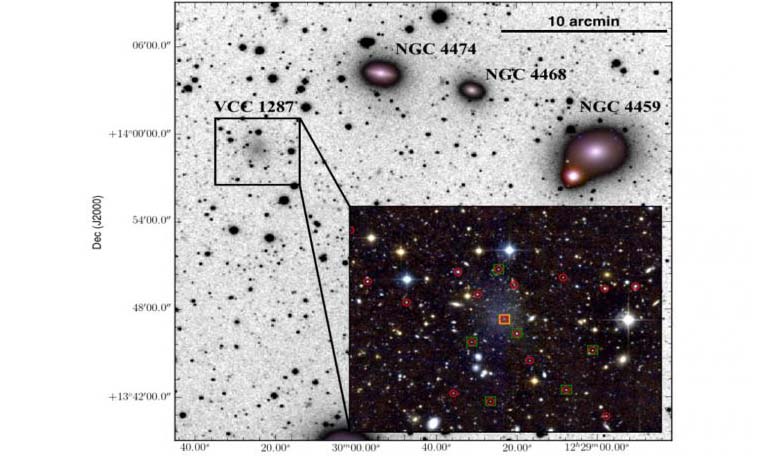Last year, much to the surprise of the astronomical community, a new type of galaxy was discovered. Known as ultra diffuse galaxies (UDGs) due to their very low surface brightnesses, researchers have now made the first measurements of a UDG known as VCC 1287 and have found that for each kilogram of ordinary material, VCC 1287 contains 3 tonnes of dark matter.
Ultra diffuse galaxies (UDGs) have the sizes of giant galaxies but the luminosities of dwarf galaxies and it is these properties that have helped UDGs stay hidden for so long. UDGs were first discovered in the Coma Cluster, a rich cluster of galaxies containing thousands of systems some 300 million light years away from Earth, but have since been detected in the Fornax, Virgo and Pisces-Perseus supercluster. Recent observations into this new type of galaxy have given rise to the suggestion that the relatively small population of UDGs found to date are just the tip of the iceberg and that many, many more wait to be discovered.
As UDGs have yet to be studied in great detail, not much is known about them at present but researchers speculate that UDGs could be the descendants of “normal” galaxies that have been altered within the cluster tidal field, or perhaps they are ancient, remnant systems – a species of “peculiar dwarf” or “failed giant.”
"These galaxies are particularly interesting, given that the violent environment in which they are situated would have destroyed them long ago were they not protected by a large amount of dark matter,” says Michael Beasley, the first author of a research paper recently published in the journal Astrophysical Journal Letters.
VCC 1287 resides within the Virgo Cluster, surrounded by a swarm of globular clusters (GCs) and it is the kinematics of seven associated GCs that Beasley and his team measured with the Gran Telescopio CANARIAS (GTC) in La Palma, in order to provide measurements of the galaxy’s dark matter content. "Globular clusters, made up of hundreds of thousands of stars, orbit within the gravitational field of the ultradiffuse galaxy," adds Aaron Romanowsky of San José State University (USA) one of the authors of the article. "The heavier a galaxy is, the more rapidly its globular clusters move, so they can be used as a cosmic balance."
Results for VCC 1287 suggest that this particular UDG has a dark [matter]-to-stellar mass fraction of ~3000, a figure the authors state is unprecedented for any galaxy besides a dwarf spheroidal. Could these systems therefore, be potential locations in which to search for dark matter? "Even though dark matter is present in other galaxies, this is an exceptional case" concludes Beasley.
Having so much dark matter could be one explanation as to why VCC 1287 has so few stars in it compared to its size, as the team speculate that the galaxy could be a “quenched” system – a massive dwarf galaxy that, due to gas starvation as it fell into the Virgo cluster, had its star formation halted early on preventing further growth due to its large dark matter content.
The team also state that results for VCC 1287 raise the possibility that there are unidentified massive galaxies lurking at even lower surface brightnesses. Nonetheless, these results prompt further explanations, as it has now got astronomers asking how is it possible that galaxies that are so diffuse but also so rich in dark matter can exist?











